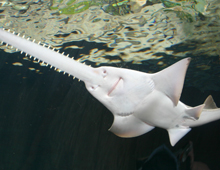Description: The body of the Freshwater or Largetooth sawfish is yellow-brown, gray, or somewhat greenish in color on the upper side and a creamy-white on the bottom side. The large, slender shark-like ray has a flattened blade-like snout (rostrum) with about 20 pairs of lateral, equally spaced teeth (are actually modified scales). Eyes on top of the head enable them to see when partly covered with mud. Located on top and back of the eyes are spiracles that allow for water to be taken in when on the bottom. The mouth, nostrils and gill slits are located on its underside. Broad based pectoral fins are tall and triangular; dorsal fins are pointed and tall, with the first dorsal fin mostly in front of the pelvic fins.
Size: Maximum size of Freshwater sawfish has been reported between 20-21.5 feet (6.1-6.6 m) in length; 1100-1400 pounds (500 to 635 kg) in weight.
Behavior: The nocturnal sawfish forages for food at night and rests on the bottom during the day. The rostrum is used to dig in sediment for food, attack prey and for defense.
Diet: Freshwater sawfish eat crustaceans, mollusks and other bottom-dwellers. Schools of fish, such as herring and mullet, make for easy foraging with the saw thrashing from side to side.
Senses: The metal detector-like rostrum, hovers over the bottom floor searching for food. Electro- and motion-sensitive pores along the length of the rostrum allow sawfish to detect movement and
even heartbeats of buried prey. Their eyesight is good but the water is often murky.
Reproduction: The Freshwater sawfish has an interesting reproduction behavior where the eggs hatch inside the female, receiving nourishment from the yolk sac and the female then gives birth to live young (ovoviviparous). The rostrum remains pliable and is enclosed in a membrane for protection to the mother while giving birth. Gestation period is approximately five months, with a litter size of between 1-12 pups. They give birth about once every two years.
Habitat/range: It is found in marine, brackish or fresh waters; inhabiting bottoms of shallow water, but can be found at depths up to 30 feet (9.1 m). Its range includes the Atlantic Ocean, eastern Pacific Ocean, East Africa to Indonesia, India, the Philippines, New Guinea and Australia.
Status: It is listed as Critically Endangered (CR) on the IUCN Red List; CITES, Appendix I.



